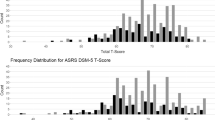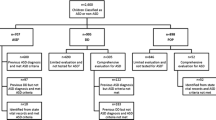Abstract
Autism Spectrum Disorders (ASD) diagnosis in very young children may be delayed due to doubts about validity. In this study, 77 children received a diagnostic and developmental evaluation between 16 and 35 months and also between 42 and 82 months. Diagnoses based on clinical judgment, Childhood Autism Rating Scale, and the Autism Diagnostic Observation Schedule were stable over time. Diagnoses made using the Autism Diagnostic Interview were slightly less stable. According to clinical judgment, 15 children (19%) moved off the autism spectrum by the second evaluation; none moved onto the spectrum. Results indicate diagnostic stability at acceptable levels for diagnoses made at age 2. Movement off the spectrum may reflect true improvement based on maturation, intervention, or over-diagnosis at age 2.

Similar content being viewed by others
References
American Psychiatric Association. (1994). Diagnostic and statistical manual of mental disorders (4th ed., DSM-IV). Washington, DC: Author.
Baranek, G. T. (1999). Autism during infancy: A retrospective video analysis of sensory-motor and social behaviors at 9–12 months of age. Journal of Autism and Developmental Disorders, 29, 213–224.
Baron-Cohen, S., Allen, J., & Gillberg, C. (1992). Can autism be detected at 18 months? The needle, the haystack, and the CHAT. British Journal of Psychiatry, 161, 839–843.
Baron-Cohen, S., Cox, A., Baird, G., Swettenham, J., Nightengale, N., Morgan, K., Drew, A., & Charman, T. (1996). Psychological markers in the detection of autism in infancy in a large population. British Journal of Psychiatry, 168, 158–163.
Bayley, N. (1993). The Bayley scales of infant development (2nd ed.). San Antonio, TX: Harcourt Brace.
Bryson, S., Rogers, S., & Fombonne, E. (2003). Autism spectrum disorders: Early detection, intervention, education, and psychopharmacological management. Canadian Journal of Psychiatry, 48, 506–516.
Charman, T., & Baird, G. (2002). Practitioner review: Diagnosis of autism spectrum disorder in 2- and 3-year-old children. Journal of Child Psychology and Psychiatry, 43, 289–305.
Cox, A., Klein, K., Charman, T., Baird, G., Baron-Cohen, S., Swettenham, J., Drew, A., & Wheelwright, S. (1999). Autism spectrum disorders at 20 and 42 months of age: Stability of clinical and ADI-R diagnosis. Journal of Child Psychology and Psychiatry and Allied Disciplines, 40, 719–732.
De Giacomo, A., & Fombonne, E. (1998). Parental recognition of developmental abnormalities in autism. European Journal of Child and Adolescent Psychiatry, 7, 131–136.
Eaves, L., & Ho, H. (2004). Brief report: Stability and change in cognitive and behavioral characteristics of autism through childhood. Journal of Autism and Developmental Disorders 26, 557–569.
Elliott, C. D. (1990). Differential ability scales (DAS). San Antonio, TX: The Psychological Corporation.
Flannagan, O., & Nuallain, S. (2001). A study looking at the effectiveness of developmental screening in identifying learning disabilities in early childhood. Irish Medical Journal, 94, 148–150.
Gillberg, C., Ehlers, S., Schaumann, H., Jakobsson, G., Dahlgren, S., Lindblom, R., Bagenholm, A., Tjuus, T., & Glidner, E. (1990). Autism under age 3 years: A clinical study of 28 cases referred for autistic symptoms in infancy. Journal of Child Psychology and Psychiatry, 31, 921–934.
Harris, S., & Handleman, J. (2000). Age and IQ at intake as predictors of placement for young children with autism: A four to six-year follow-up. Journal of Autism and Developmental Disorders, 30, 137–142.
Howlin, P., & Ashgarian, A. (1999). The diagnosis of autism and Asperger syndrome: Findings from a systematic survey. Developmental Medicine and Child Neurology, 41, 834–839.
Jocelyn, L., Casiro, O., Beattie, D., Bow, J., & Kneisz, J. (1998). Treatment of children with autism: A randomized controlled trial to evaluate a caregiver-based intervention program in community day-care center. Journal of Developmental and Behavioral Pediatrics, 19, 326–334.
Lord, C. (1995). Follow-up of two-year-olds referred for possible autism. Journal of Child and Adolescent Psychiatry, 36, 1365–1382.
Lord, C., Shulman, C., & DiLavore, P. (2004). Regression and word loss in autistic spectrum disorders. Journal of Child Psychology and Psychiatry, 45, 936–955.
Lord, C., Storoschuk, S., Rutter, M., & Pickles, A. (1993). Using the ADI-R to diagnose autism in preschool children. Infant Mental Health Journal, 14, 234–252.
Lord, C., Rutter, M., & Le Couteur, A. (1994). Autism diagnostic interview-revised: A revised version of a diagnostic interview for caregivers of individuals with possible pervasive developmental disorders. Journal of Autism and Developmental Disorders, 24, 659–685.
Lord, C., Rutter, M., DiLavore, P., & Risi, S. (1999). Autism diagnostic observation schedule-WPS edition. Los Angles, CA: Western Psychological Services.
Mays, R., & Gillon, J. (1993). Autism in young children: An update. Journal of Pediatric Health Care, 7, 17–23.
Moore, V., & Goodson, S. (2003). How well does early diagnosis of autism stand the test of time? Follow-up study of children assessed for autism at age 2 and development of an early diagnostic service. Autism, 7, 47–63.
Mullen, E. (1995). Mullen scales of early learning. Circle Pines, MN: American Guidance Service.
Osterling, J., & Dawson, G. (1994). Early recognition of children with autism: A study of first birthday home videotapes. Journal of Autism and Developmental Disorders, 24, 247–257.
Prizant, B., & Wetherby, A. (1988). Providing services to children with autism (ages 0 to 2 years) and their families. Focus on Autistic Behavior, 4, 1–16 (Reprinted from (1988). Topics in Language Disorders, 9, 1–23).
Robins, D., Fein, D., Barton, M., & Green, J. (2001). The modified checklist for autism in toddlers: An initial study investigating the early detection of autism and pervasive developmental disorders. Journal of Autism and Developmental Disorders, 31, 131–144.
Schopler, E., Reichler, R., & Renner, B. (1988). The childhood autism rating scale. Los Angeles: Western Psychological Services.
Siegel, B., Pliner, C., Eschler, J., & Elliott, G. (1988). How children with autism are diagnosed: Difficulties in identification of children with multiple developmental delays. Journal of Developmental and Behavioral Pediatrics, 9, 199–204.
Sparrow, S., Balla, D., & Cicchetti, D. (1984). The vineland adaptive behavior scales. Circles Pines, MN: American Guidance Services.
Stone, W., & Hogan, K. (1993). A structured parent interview for identifying young children with autism. Journal of Autism and Developmental Disorders, 23, 639–652.
Stone, W., Lee, E., Ashford, L., Brissie, J., Hepburn, S., Coonrod, E., & Weiss, B. (1999). Can autism be diagnosed accurately in children under 3 years?. Journal of Child Psychology and Psychiatry and Allied Disciplines, 40, 219–226.
Sutera, S., Pandey, J., Esser, E., Rosenthal, M., Wilson, L., Barton, M., Green, J., Hodson, S., Robins, R., Dumont-Mathieu, T., & Fein, D. (2007). Predictors of optimal outcome in toddlers diagnosed with autism spectrum disorders. Journal of Autism and Developmental Disorders, 37, 98–107.
Ventola, P., Kleinman, B., Pandey, J., Barton, M., Allen, S., Green, J., Robins, D., & Fein, D. (2006). Agreement among four diagnostic instruments for autism spectrum disorders in toddlers. Journal of Autism and Developmental Disorders, 36, 839–847.
Volkmar, F., Chawarska, K., & Klin, A. (2005). Autism in infancy and early childhood. Annual Review of Psychology, 56, 315–336.
Acknowledgments
We gratefully acknowledge the assistance of participating pediatricians and staff in their offices, as well as providers in the Connecticut and Massachusetts Birth-to-Three Early Intervention systems. We would like to thank Jillian Wood, Executive Director of the Hezekiah Beardsley Chapter of the American Academy of Pediatrics, who assisted in recruiting participating physician offices and promoted the study state-wide, as well our dedicated undergraduate research assistants, and the children and families who participated. We would also like to extend sincere thanks to members of the Early Detection Advisory Board, especially Ho-Wen Hsu, MD, and Mark Greenstein, MD, for their wise advice and support. Graduate students Leandra Berry, Hilary Boorstein, Emma Esser, Saasha Sutera, and Mike Rosenthal, and Gail Marshia, Project Coordinator, were invaluable in conducting all aspects of the study. This paper was prepared from the masters thesis of Jamie M. Kleinman at the University of Connecticut. This study is supported by NIH grant R01 HD039961 and Maternal and Child Health Bureau grant R40 MC00270 and prior grants from the National Association for Autism Research, NIMH, and the Department of Education.
Author information
Authors and Affiliations
Corresponding author
Rights and permissions
About this article
Cite this article
Kleinman, J.M., Ventola, P.E., Pandey, J. et al. Diagnostic Stability in Very Young Children with Autism Spectrum Disorders. J Autism Dev Disord 38, 606–615 (2008). https://doi.org/10.1007/s10803-007-0427-8
Received:
Accepted:
Published:
Issue Date:
DOI: https://doi.org/10.1007/s10803-007-0427-8




